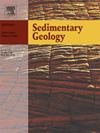日本德野岛小丸海滩瀑布状凝灰岩近200年的高分辨率同位素记录
IF 2.9
2区 地球科学
Q1 GEOLOGY
引用次数: 0
摘要
具有年生长带和大生长速率的叠层石凝灰岩是高分辨率古气候重建的重要资料。然而,在河流环境中形成的凝灰岩通常缺乏沉积的连续性。为了获得连续记录,一种潜在的研究材料是生长在瀑布下方的瀑布型凝灰岩。在这里,我们研究沿着日本德野岛小丸海滩的凝灰岩,那里发育着瀑布型凝灰岩。3个不同沉积背景的凝灰岩样品的氧碳同位素比值(δ18O和δ13C)提供了降水模式和水温的信息。来自河流背景的凝灰岩样本显示出清晰的年轮,快速的生长速率,以及同位素组成在大约20年中的季节性变化。石笋型和瀑布型凝灰岩年轮不太清晰,生长速率较低,在近200年的时间里保持了连续的记录,是现代凝灰岩中最长的记录。从20世纪80年代开始,瀑布型凝灰岩的δ13C呈下降趋势,这可能是化石燃料消耗和降水增加的结果。此外,级联型凝灰岩的δ13C值在干燥段呈增大趋势,在湿润段呈减小趋势。另一方面,δ18O的周期约为20年。雨水样品的分析表明,凝灰岩的δ18O反映了降雨的季节性,这种季节性继承于雨水的δ18O。实际记录与凝灰岩δ18O重建的季节特征吻合,验证了这一解释。虽然瀑布型凝灰岩不提供次年分辨率,但它们是有价值的百年尺度气候档案,使我们能够研究年代际尺度的气候变率,如太平洋年代际涛动。本文章由计算机程序翻译,如有差异,请以英文原文为准。
High-resolution isotopic records for the last 200 years from cascade tufas on Kobaru Beach, Tokunoshima Island, Japan
A stromatolitic tufa with annual growth bands and a large growth rate is a promising archive for high-resolution paleoclimate reconstruction. However, a tufa formed in a fluvial setting typically lacks continuity of deposition. To obtain a continuous record, a potential study material is a cascade-type tufa growing below a waterfall. Here, we study tufas along Kobaru Beach on Tokunoshima Island, Japan, where cascade-type tufas are developed. Oxygen and carbon isotope ratios (δ18O and δ13C) of tufa samples collected from three sites with different sedimentary settings provide information about precipitation patterns and water temperature. A tufa sample from a fluvial setting exhibits clear annual growth rings, rapid growth rates, and seasonal changes in isotopic composition over approximately 20 years. Tufas of the stalagmite-type and cascade-type, having less clear annual growth rings and lower growth rates, preserve continuous records over the last 200 years, the longest record from the modern tufas. The δ13C of the cascade-type tufa shows a decreasing trend from the 1980s, which is interpreted as a result of fossil fuel consumption and an increase in rainfall. In addition, the δ13C of the cascade-type tufa tends to increase in dry intervals and decrease in humid intervals. On the other hand, an approximately 20-year periodicity is observed in the δ18O. Analysis of rainwater samples implies that the δ18O of tufa reflects the seasonality of rainfall, which is inherited from the rainwater δ18O. This interpretation is verified by the consistency between the actual record and the seasonality reconstructed by the tufa δ18O. While cascade-type tufas do not provide sub-annual resolution, they serve as valuable centennial-scale climate archives, which allow us to investigate decadal-scale climate variability, such as Pacific Decadal Oscillation.
求助全文
通过发布文献求助,成功后即可免费获取论文全文。
去求助
来源期刊

Sedimentary Geology
地学-地质学
CiteScore
5.10
自引率
7.10%
发文量
133
审稿时长
32 days
期刊介绍:
Sedimentary Geology is a journal that rapidly publishes high quality, original research and review papers that cover all aspects of sediments and sedimentary rocks at all spatial and temporal scales. Submitted papers must make a significant contribution to the field of study and must place the research in a broad context, so that it is of interest to the diverse, international readership of the journal. Papers that are largely descriptive in nature, of limited scope or local geographical significance, or based on limited data will not be considered for publication.
 求助内容:
求助内容: 应助结果提醒方式:
应助结果提醒方式:


